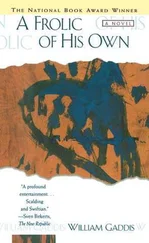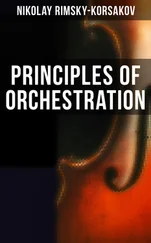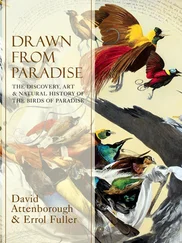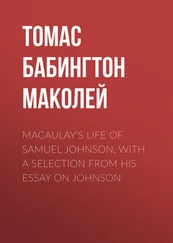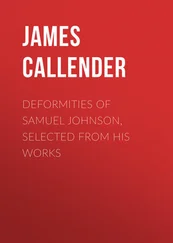The special function of the harp lies in the execution of chords, and the florid figures springing from them. As only four notes at the most can be played by each hand, the notes of a chord should be written close together, with not too great a space between one hand and the other. The chords must always be broken ( arpeggiato ); should the composer wish otherwise he should notify it ( non arpeggiato ). In the middle and lower octaves the resonance of the strings is slightly prolonged, and dies away gradually. In changes of harmony the player stops the vibration of the strings with his hands, but, in quick modulations, this method is not feasible, and the mixture of one chord with another produces a discordant effect. It follows that more or less rapid figures can only be realised clearly and neatly in the upper register of the harp, where the strings are shorter and harder in tone.
As a general rule, in the whole range of the harp:
only the notes of the first to the fourth octave are used; the extreme notes in both compasses may be employed in special circumstances, and for doubling in octaves.
The harp is essentially a diatonic instrument, since all chromatic passages depend on the manipulation of the pedals. For this reason the harp does not lend itself to rapid modulation, and the orchestrator is advised to bear this fact in mind. But the difficulty may be obviated by using two harps alternately. [10]
Note. I would remind the reader that the harp is not capable of double sharps or double flats. For this reason, certain modulations from one key to another one, adjacent to it can only be accomplished enharmonically. For instance, the transition from C flat, G flat or D flat, major to their minor subdominant chords or keys is not possible owing to double flats. It is therefore necessary to start enharmonically from the keys of B , F sharp or C sharp, major. Similarly, on account of double sharps, it is impossible to change from A sharp, D sharp or G sharp, minor to their respective dominant major chords or keys; B flat, E flat and A flat, minor must be the starting-points.
The technical operation known as glissando is peculiar to the harp alone. Taking for granted that the reader is conversant with the methods of acquiring different scales by means of double-notched pedals, it will be sufficient to remark that glissando scales produce a discordant medley of sound owing to the length of time the strings continue to vibrate, and therefore, as a purely musical effect, glissando can only be used in the upper octaves, quite piano , where the sound of the strings is sufficiently clear, yet not too prolonged. Forte glissando scales, entailing the use of the lower and middle strings are only permissible as embellishments. Glissando passages in chords of the seventh and ninth, enharmonically obtained, are much more common, and as the above reservations do not apply, every dynamic shade of tone is possible. Chords in harmonics can only consist of three notes written close together, two for the left hand and one for the right.
The tender poetic quality of the harp is adapted to every dynamic shade, but it is never a very powerful instrument, and the orchestrator should treat it with respect.
At least three, if not four harps in unison are necessary, if they are to be heard against a full orchestra playing forte . The more rapidly a glissando passage is played, the louder it will sound. Harmonic notes on the harp have great charm but little resonance, and are only possible played quite softly. Speaking generally, the harp, like the string quartet, pizzicato , is more an instrument of colour than expression.
Percussion instruments producing determinate
sounds, keyed instruments.
Kettle-drums.
Kettle-drums, indispensable to every theatre and concert orchestra occupy the most important place in the group of percussion instruments. A pair of kettle-drums ( Timpani ), in the tonic and dominant keys, was the necessary attribute of an orchestra up to, and including Beethoven's time, but, from the middle of the 19th century onward, in western Europe and in Russia, an ever-increasing need was felt for the presence of three or even four kettle-drums, during the whole course or part of a work. If the expensive chromatic drum, permitting instant tuning is rarely met with, still, in the majority of good orchestras, three screw drums are generally to be found. The composer can therefore take it for granted that a good timpanist, having three kettle-drums at his command, will be able to tune at least one of them during a pause of some length.
The limits of possible change in Beethoven's time was considered to be:
| Big kettle-drum: |
 |
Small kettle-drum: |
 |
In these days it is difficult to define the precise extent of high compass in the kettle-drums, as this depends entirely on the size and quality of the smallest one, of which there are many kinds, but I advise the composer to select:
Note. A magnificent kettle-drum of very small size was made for my opera-ballet Mlada ; this instrument gave the D♭ of the fourth octave.
Kettle-drums are capable of every dynamic shade of tone, from thundering fortissimo to a barely perceptible pianissimo . In tremolando they can execute the most gradual crescendo , diminuendo , the sfp and morendo .
To deaden the sound, a piece of cloth is generally placed on the skin of the drum, according to the instruction: timpani coperti (muffled drums).
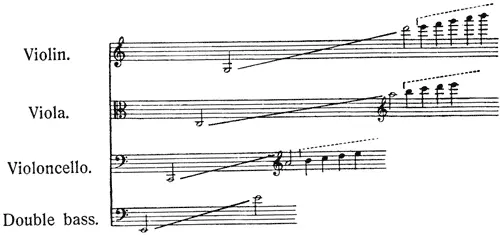
The black notes are dry and hard, without resonance, and should only be used when doubled with the wood-wind.
* Table E.
Glockenspiel, celesta, xylophone.
The use of a piano in the orchestra (apart from pianoforte concertos) belongs almost entirely to the Russian school. [11]The object is two-fold: the quality of tone, either alone, or combined with that of the harp, is made to imitate a popular instrument, the guzli, (as in Glinka), or a soft peal of bells. When the piano forms part of an orchestra, not as a solo instrument, an upright is preferable to a grand, but today the piano is gradually being superseded by the celesta, first used by Tschaikovsky. In the celesta, small steel plates take the place of strings, and the hammers falling on them produce a delightful sound, very similar to the glockenspiel . The celesta is only found in full orchestras; when it is not available it should be replaced by an upright piano, and not the glockenspiel .
Glockenspiel, Bells, Xylophone.
The glockenspiel ( campanelli ) may be made of steel bars, or played with a keyboard. The first type is the more satisfactory and possesses greater resonance. The use of the glockenspiel is similar to the celesta, but its tone is more brilliant and penetrating. Big bells in the shape of hollow discs or metal tubes, [12]or real church bells of moderate size may be considered more as theatrical properties than orchestral instruments.
Читать дальше




